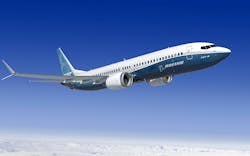On Sunday, December 11, Boeing Commercial Airplanes confirmed details of its long-anticipated sale to Iran Air, the flag carrier of the Islamic Republic of Iran. The jet builder will supply a total of 80 jets — 50 737 MAX 8s, 15 777-300ERs, and 15 777-9s — the total value of which it estimated at $16.6 billion. The first aircraft are due to be delivered in 2018.
The 737 MAX is the latest version of Boeing’s narrow-body passenger jet series, the first model of which is due to make its commercial debut in 2017. The redesigned 737 is powered by two CFM International LEAP-1B engines, and incorporates multiple material selections and aerodynamic designs to achieve fuel efficiency and performance reliability for the operators.
The 777 is a wide-body, long-range jet series. The 777-300ER is the current model, of which more than 800 have been ordered to-date, Boeing noted.
The 777X is a redesigned version set to debut in 2020; it will be powered by the GE Aviation GE9X engines, also in development, and various lightweight materials and technologies, as established by Boeing’s 787 Dreamliner series.
The sale was made possible once the trade sanctions imposed against Iran in connection with its nuclear weapons development program were lifted earlier this year.
In June Boeing reached a Memorandum of Agreement with Iran Air defining the terms of the sale, and in September it gained a federal license to complete the sale.
The timing of the announcement, on a Sunday, and Boeing’s emphasis that “it coordinated closely with the U.S. Government throughout the process, … and continues to follow all license requirements as it moves forward to implement the sales agreement,” make clear how sensitive the OEM is to criticism of the sale.
Boeing also underscored that the sale to Iran Air will “support tens of thousands of U.S. jobs directly associated with production and delivery of the 777-300ERs and nearly 100,000 U.S. jobs in the U.S. aerospace value stream for the full course of deliveries.”
Iranian firms had been prohibited from selling or purchasing products with U.S. and E.U. companies due to the long-standing economic, trade, scientific, and military sanctions against the Islamic Republic, resulting from its nuclear-fuel development program. In place since 1995, the terms included a ban on selling aircraft and repair parts to Iranian aviation companies. This heightened the need for Iran Air to update and replace its commercial jet fleet.
In January, the U.S. and E.U. lifted oil and financial sanctions against Iran and released about $100 billion of its assets. The matter remains politically controversial in the U.S. because the Obama Administration structured the agreement ending the sanctions as a “waiver”, rather than risking the outcome by submitting the terms for approval by the Congress, as trade agreements are required.
About the Author
Robert Brooks
Content Director
Robert Brooks has been a business-to-business reporter, writer, editor, and columnist for more than 20 years, specializing in the primary metal and basic manufacturing industries.
